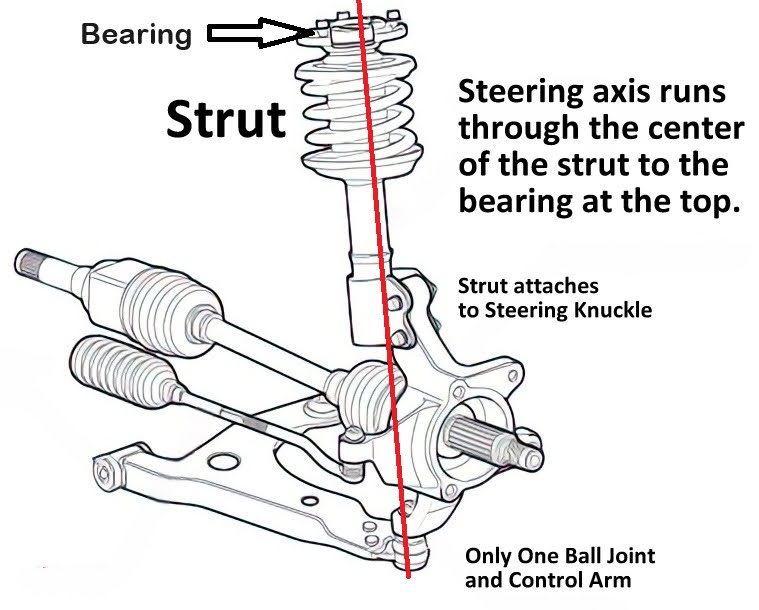Strut mount bearings are crucial suspension parts that can be found in the front suspension, where they help drivers steer and control their vehicles.
These bearings serve as pivot points for your car’s two front strut assemblies. They allow the struts to rotate alongside the wheels when you turn the steering wheel.
Because of their role, bad strut mount bearing systems can cause many problems, most of which can negatively affect your driving. They can cause problems so serious that paying for repairs can be considered getting off light. For example, they can make you lose control, increasing the risk of collision accidents.
That’s why it pays to keep an eye out for the symptoms of bad strut mount bearings.
Note: You can learn more about struts in our discussion about suspension types and wheel alignment.
Signs You Should Replace Your Strut Mount Bearing
Having difficulties when steering, uneven tire wear, and squeaking noises from the suspension are some of the symptoms of a bad strut mount bearing.

Difficulty Steering
Faulty strut mount bearings can (but won’t usually) make the steering wheel unresponsive or perhaps slightly jerky and somewhat more difficult to turn.
Uneven Tire Wear
If the strut mount bearing is damaged, the strut mount will likely malfunction. This can shift the angle of the wheels and the vehicle’s weight distribution, making tires wear unevenly or causing steering pull and wander.
But this is only true if the strut mount bearing has totally come apart so that the top of the strut is moving around. You will have noticed other symptoms long before the strut mount reaches this stage.
Squeaking Noises
Typically, driving over speed bumps and potholes shouldn’t cause your vehicle to make strange noises. However, if the strut mount bearing is bad or not lubricated properly, components will grind against one another, creating clunky squeaking noises.
What Happens if You Don’t Replace Bad Strut Mount Bearings?
Depending on the severity of the damage to the strut mount bearing, your ability to control your vehicle will be compromised.
As previously mentioned, a worn strut mount bearing will make it more difficult to steer your vehicle. So, for everyone’s safety, it’s important to get a bad strut mount bearing replaced as soon as possible.
Failing to replace a bad strut mount bearing can also lead to other problems. For example, your suspension system might bounce unevenly, making you veer off course when driving. The faulty bearings can also put more strain on crucial components, such as ball joints, struts, and tie rod ends.
How Much Do Strut Mount Bearing Replacements Cost?
The cost of a strut mount bearing replacement varies depending on the make and model of your vehicle. You can expect to spend between $300 and 500 for both the replacement parts and labor costs.
The replacement process typically takes two hours to complete, but a skilled mechanic can finish it in one.
How Often Should Strut Mount Bearings Be Replaced?
A good strut mount bearing can last between 50,000 and 75,000 miles before needing a replacement. This means the average driver will have to replace the strut mount bearing of their vehicle at least once every four years.
If you regularly bring your vehicle to the auto shop for maintenance, your mechanic should be able to tell if anything’s wrong with your vehicle. If they recommend replacing your vehicle’s strut mount bearing because they’ve noticed something wrong with it, it’s a good idea to listen to them.
Frequently Asked Questions About Strut Mount Bearings
Here are some of the most commonly asked questions about strut mount bearings.
Can you lubricate strut mount bearings?
Yes, you can lubricate the strut mount bearings with grease. Bear in mind that you should only do so if there is no longer any grease or lubricant. There’s no benefit to adding more grease to strut mount bearings that have already been lubricated.
How long do strut mount bearings typically last?
Though strut mount bearings typically need to be replaced once every four years, this isn’t always the case.
With proper care and maintenance, you might never have to replace your vehicle’s strut mount bearings. On the other hand, bearings that are poorly maintained and insufficiently lubricated might not even last four years.
What typically damages strut mount bearings?
Driving over potholes and bumps can damage strut mount bearings. Environmental factors can also increase wear and tear. This is typically brought about by salt, high humidity, water contamination, ice, and temperature fluctuations.
Any information provided on this Website is for informational purposes only and is not intended to replace consultation with a professional mechanic. The accuracy and timeliness of the information may change from the time of publication.






































